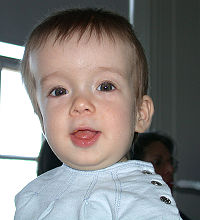
Photo from wikipedia
BACKGROUND Minor cranial sutural synostosis is currently regarded as a rare diagnosis. As clinical awareness grows, a greater number of cases are being documented. This study aims to describe the… Click to show full abstract
BACKGROUND Minor cranial sutural synostosis is currently regarded as a rare diagnosis. As clinical awareness grows, a greater number of cases are being documented. This study aims to describe the variants of unicoronal synostosis with regard to major and minor sutural involvement and secondary effects on cranial and orbital morphology. The information is aimed to improve clinical diagnosis and management. METHODS A retrospective study was conducted collecting preoperative computed tomographic scans of patients diagnosed with unicoronal synostosis and listed for surgical interventions, identified from a craniofacial database. Within these patients, different synostotic variants were identified based on which suture was affected. Scans of normal pediatric skulls (trauma) were used for a control group. Computed tomographic scans were analyzed for sutural involvement, cranial base deflection, and ipsilateral and contralateral orbital height and width. One-way analysis of variance was used to detect differences between synostotic variants and controls. RESULTS A total of 57 preoperative computed tomographic scans of patients with unicoronal synostosis were reviewed, in addition to 18 computed tomographic scans of normal skulls (control group). Four variants of unicoronal synostosis were identified: frontoparietal, frontosphenoidal, frontoparietal and frontosphenoidal, and frontosphenoidal and frontoparietal. The last two variants differ in their temporal involvement in the direction of sutural synostosis and ultimately cranial and orbital morphology. Three variants have been previously identified, but the fourth is presented for the first time. CONCLUSIONS An understanding of the variants of unicoronal synostosis and their temporal relationships is integral for accurate clinical diagnosis and surgical correction. Recommendations for treatment are based on discrete changes in orbital morphology.
Journal Title: Plastic and reconstructive surgery
Year Published: 2019
Link to full text (if available)
Share on Social Media: Sign Up to like & get
recommendations!